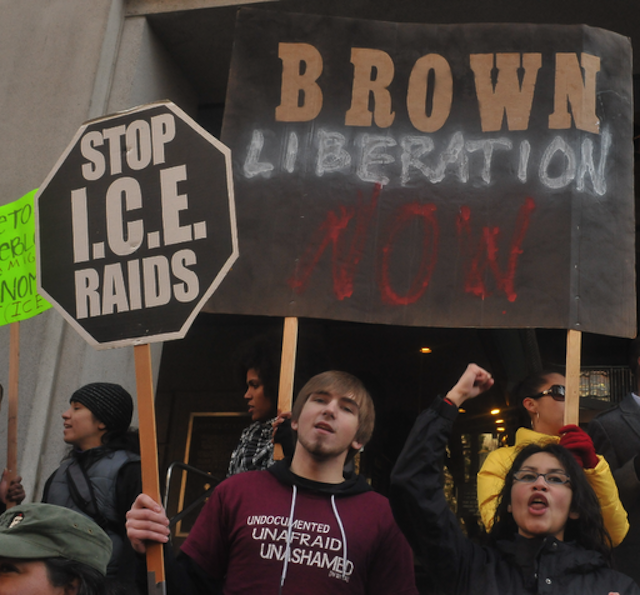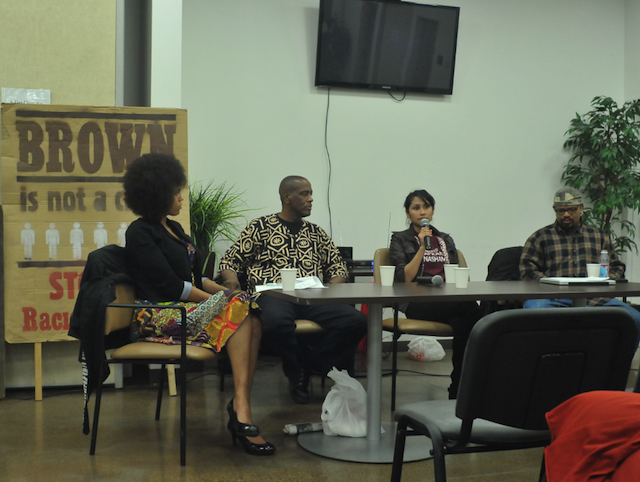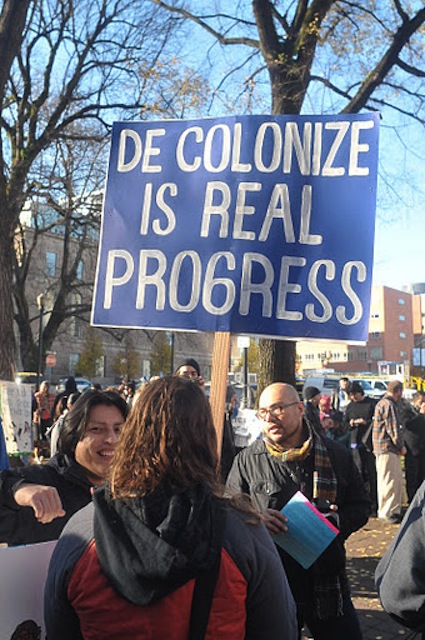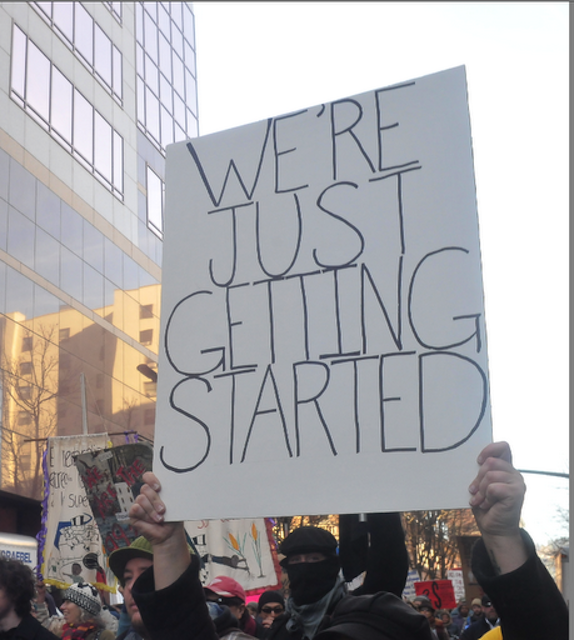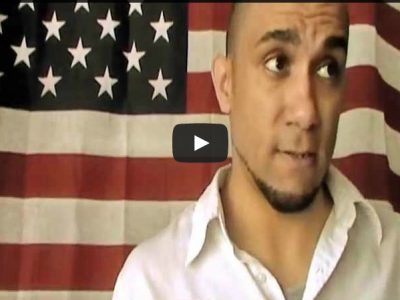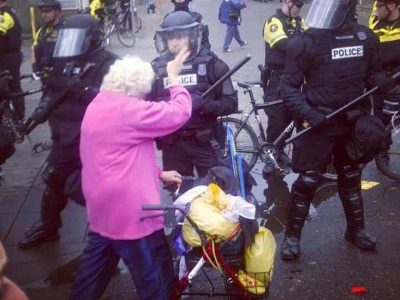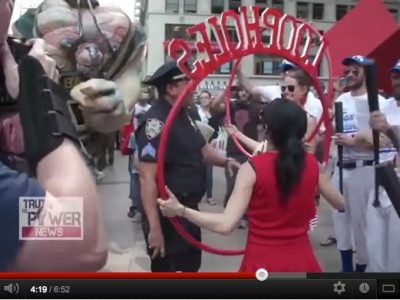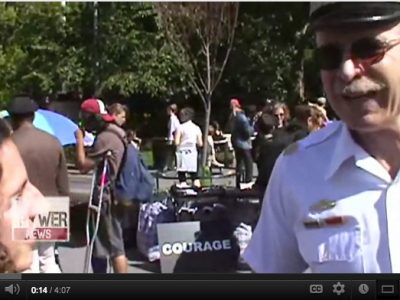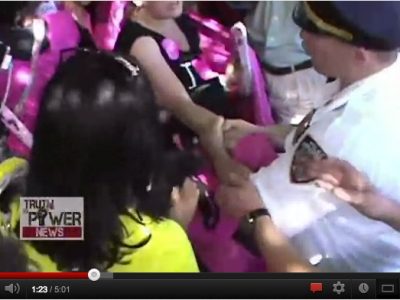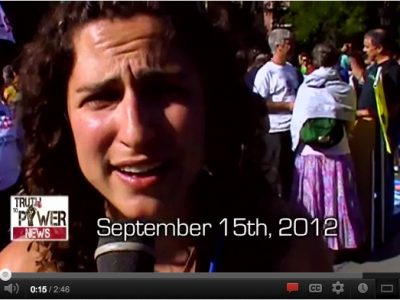Story and photos by Pete Shaw
Sindy Avila is a member of the Oregon Dream Activists, a group working to advance immigrant rights and the rights of all people of color. Speaking at a forum about creating community control and putting radical politics into practice in communities of color, she noted that as the Dream Activists resisted Immigration and Customs Enforcement (ICE) deportations and the fear and resultant internalized oppression they engendered in the immigrant community, they began creating their own narrative, one different from and competing with that told by ICE and its dutiful corporate media ciphers.
“Community control is about claiming our presence,” said Avila, “and using our voices. We don’t need someone to speak for us. We are shaping the public narrative and fighting to have a different reality.”
The Community Control Panel, organized by Decolonize PDX and held at Miracles Club on NE Martin Luther King Boulevard on November 15th, was attended by over 70 people. The panelists — Avila, Mic Crenshaw who organizes for We Are Oregon, Occupy Northeast Black Working Group and emcees, and Ahjamu Umi of the Black Working Group and Blazing Arrow — discussed a series of questions posed by moderator Walidah Imarisha and then responded to questions from the audience.
“Community Control” is a term that has been tossed about since the Occupy Movement sprouted over a year ago, and its roots go back much further, centers on the question of how much control people should have over their own lives. It is that issue of “how much” that is at the heart of defining community control and creating a vision that can be constructed. You don’t have to look too far to see that the normative vision of community control involves little control over our communities. It largely revolves around consumer choices — McDonald’s or Burger King? Target or Wal-Mart? — while substantive issues of control and allocation of resources remain generally out of our hands. After all, if we really had control over our resources, would Nestle have a snowball’s chance in hell of constructing a water bottling plant in the Columbia River Gorge? Would coal trains possibly running through Portland spewing coal dust causing asthma, cancer, and mercury poisoning even be an issue?
At its heart, community control is “an issue of sovereignty, accountability, and responsibility we don’t have when we give it to elected officials” and that community power is when “we take it back,” said Crenshaw.
Umi stressed that we also need to place our notions of community and control in historical context. After all, the communities about which we are talking sit on native land; if you are non-native, then you are either an invader or a slave descendant. This fact, said Umi, must always be considered when speaking of community control, and real community control must involve bonds between all communities, both here and abroad.
Avila then applied community control to bedrock daily realities for the immigrant community, explaining the need for control was imperative due to racist laws and procedures that have cut off avenues to healthcare, education, and high wage jobs for people without documentation.
In the spirit of Ernest Hemingway, who wrote that one should never confuse movement with action, the conversation moved from vision and purpose to the concrete: what are people doing to achieve greater control over their communities?
Avila talked about the campaign to educate the public about ICE sweeps and deportations. At first, ICE raids, sweeps, and deportations were justified as enforcing immigration law. This did not go over well with the public who saw families being cruelly torn apart after years of toiling in difficult, low wage jobs, their only crime being trying to make a better life for themselves and their children. So ICE changed the narrative, rebranding immigration as a security issue and reinventing immigrants – particularly those with brown skin – as dangerous criminals who should be removed from society for our safety.
Try as one might, it is a tough dollar getting people worked up over the dire threat a farm worker poses to their well-being. In fact, earlier this year many Georgia farmers found that when the state passed its draconian House Bill 87 that effectively made it illegal to have brown skin in Georgia, a lack of farmworkers presents deep economic problems both for farmers, who either have to watch produce rot or pay much higher wages to pickers unused to the backbreaking work, and consumers who saw food costs rise.
ICE transformed brown skinned immigrants into drug dealers and violent criminals, and their deportations – constantly accompanied by this newly minted ICE rhetoric — reinforced these stereotypes. But the fact of the matter is that over 80% of those rounded up by ICE are taken in for misdemeanors and traffic violations. Instead of ICE’s Secure Communities program based on racist rhetoric and broad stroke stereotypes, the immigrant rights movement has been promoting Safe Communities, where the community resists ICE roundups and deportations. The movement has been successful enough that in June President Obama, in the middle of his reelection campaign, felt compelled to issue an executive order granting legal status to undocumented immigrants who had been in the country at least five years, were younger than 30, and had been brought here before they turned 16.
Imarisha noted that Secure Communities was not criminalizing behavior as much as making “looking illegal” a criminal act. Contending that this is “the system working as intended,” she connected Secure Communities to a larger history of controlling, containing, and castigating communities of color. Alternatively, she said, community control is about restoration, not punishment.
Umi talked about the housing defense work in which he has been involved, particularly keeping people in their homes and teaching them not to fear police. Black Working Group and Blazing Arrow have been talking to people on MAX, videotaping police as they engage people, and telling people their rights. Particularly, Umi emphasized their work in teaching people they don’t need the police in their neighborhoods, that they can police themselves. It is no surprise this work has been well received, given the way in which Portland Police deal with people with mental illness and their poor relationship with communities of color, as documented in the Department of Justice report issued this summer.
Moving on to the subject of state oppression and building alternate communities, Imarisha noted that there is always a state reaction when people start taking their own power. Umi related this to the eviction resistance movement in Portland, especially evident in the high police presence at two recent evictions.
“Power never gives up power. You can either bow down in fear to that or stand up to it. The more you stand up, the more they resist,” Umi said. He went on to note that “more repression leads to more resistance,” a truth borne out in Portland by the tremendous growth in both the immigrant rights and the eviction resistance movements.
Avila detailed how the immigrant rights movement has reclaimed “space, dignity, and humanity just by getting out of the shadows”. It also has turned the tables on those in power through organized actions that have surprised its targets. For example, in July seven undocumented National Immigrant Youth Alliance organizers, including one Oregon Dream Activists organizer, risked arrest and deportation in an effort to infiltrate the Broward Detention Center in Florida to organize detainees who, according to the Obama administration, should no longer be facing deportation due to discretion on low priority cases.
The activists committed civil disobedience in Florida and were taken to the detention center where they began gathering the stories of other ICE detained immigrants. Their publicly released findings revealed that the vast majority were detained for misdemeanors and traffic violations – essentially for looking illegal. Those seven activists turned the table on the state, using its means of repression to break the hold it had on the media narrative. “We shouldn’t be afraid by how oppressive systems make us feel,” she said, “We are showing how strong we are, and it puts fear in them.”
Imarisha then directed the conversation to the global stage, asking panelists how they saw the Occupy Movement engaging in global struggle. Crenshaw said he viewed Occupying parks as temporary, but knew that it would evolve and those involved would move to other struggles such as the housing justice and Undocumented and Unafraid movements. Crenshaw said he believed the answers to how to create community control were simple, essentially boiling down to saying to illegitimate sources of authority, “You know what? I’m not gonna do that. You’re going to have to change.” Echoing the overarching theme of the forum, Crenshaw told the crowd, “We don’t need to call in an outside force. We can create the solution.”
Imarisha then asked panel members for examples of when they came to realize how much power people really had to make change.
Umi talked about his experience helping people stay safe during the 1992 Los Angeles riots. Some people were looting a bond store when two police cars drove up. The looting continued despite police warnings. Four policemen then came out of the cars with their weapons and suddenly found themselves surrounded by 100 people in no mood to deal with them. As the officers’ bravado went up in smoke – with three of them running away and the last one turning tail only after grabbing some loot for himself – Umi realized how much power people have when they’re unafraid.
The question then became one of how long that usurpation of power would last. Umi said the answer to that question lay in the words of Kwame Ture, that a mobilizing moment must be turned into an organizing moment so that the gains in power are consolidated.
Avila noticed how much power the immigrant community had when large numbers of undocumented people in the community began taking action to create an agenda instead of waiting to react to someone else’s. She says now the immigrant community is not engaged solely in a debate over documentation, immigration, and deportation, but moving the conversation to these issues as problems of capitalism.
Bringing up the rally outside the Multnomah County Building on November 9th as people gathered to demand Sheriff Staton stop evicting people from their houses, Crenshaw observed how a few hours prior to the rally Staton left the building instead of facing the crowd. “The opponent seems mightier than you,” said Crenshaw, “but if you have a team, you have the power. Our enemy is finding we’re mightier. He’s failing because he’s using his power and it’s not working. The bonds of love and trust of community are power.”
When asked about making connections between different communities of color, all panelists agreed it was something that needed to be done with care and respect. “As people of color we need space to deconstruct 500 years of Babylon,” Umi said, and talked about the Broken Arrow Organization which he described as “multi-racial with separate components.” The different groups making up BAO – Black Youth Caucus, Young Latino Working Caucus, and John Brown’s Body, to name a few – meet individually as well as coming together collectively, an important point, said Umi, for fostering solidarity and creating the space to fight the confusion created by a sophisticated propaganda system that denies alternative models.
The final subject was the connection between culture and art. Art has always played a role in struggle: slaves had their spirituals, the civil rights movement had its soundtrack, and the Occupy encampments saw a flourish of both visual art and music. “Art is a necessary part of cultural expression,” said Crenshaw, including art that lacks seriousness. He felt it was important for those engaged in struggle to engage and support art that develops consciousness.
“Art must wake people up to the contradictions of the world,” said Umi, adding that it should be used to make the world a better place.
The floor was then opened to the audience. One query dealt with the interplay between community control and making demands of those in power. Imarisha stated how people must both push back against power and build alternatives that will take up the opened space. “We have to have a long range goal,” she said, “and not just constantly be fighting.”
Another question dealt with how people fighting for greater community power can move from a position of reaction to one of creation. Umi emphasized the importance of committing to study “who we are and who we’re up against.” Particularly he stressed work study circles as a source of ideological strengthening, so that people could hold firmly on their principles.
Despite the fact that history is replete with the victories of those who fought on against what once seemed insurmountable odds, it’s often the case that naysayers will tell social activists, “You can’t beat City Hall”. The Community Control Panel provided a few successful and ongoing blueprints to counter that complaint, a reminder that the power to craft the change we want to see in our communities lies within the people of our communities.
Want to get involved?
For more information about Decolonize PDX go to: http://decolonizepdx.weebly.com/
For more information about Blazing Arrow Organization go to: http://blazing-arrow.tumblr.com/
For more information about Black Working Group go to: http://www.facebook.com/pages/Occupy-Northeast-The-Black-Working-Group/303186503078158
For more information about the Dream Activists go to: http://www.dreamactivist.org/
For more information about the National Immigrant Youth Alliance go to: http://theniya.org/

